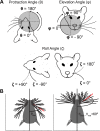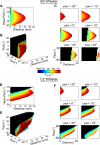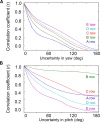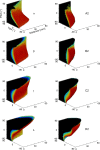Evidence for Functional Groupings of Vibrissae across the Rodent Mystacial Pad
- PMID: 26745501
- PMCID: PMC4706419
- DOI: 10.1371/journal.pcbi.1004109
Evidence for Functional Groupings of Vibrissae across the Rodent Mystacial Pad
Abstract
During natural exploration, rats exhibit two particularly conspicuous vibrissal-mediated behaviors: they follow along walls, and "dab" their snouts on the ground at frequencies related to the whisking cycle. In general, the walls and ground may be located at any distance from, and at any orientation relative to, the rat's head, which raises the question of how the rat might determine the position and orientation of these surfaces. Previous studies have compellingly demonstrated that rats can accurately determine the horizontal angle at which a vibrissa first touches an object, and we therefore asked whether this parameter could provide the rat with information about the pitch, distance, and yaw of a surface relative to its head. We used a three-dimensional model of the whisker array to construct mappings between the horizontal angle of contact of each vibrissa and every possible (pitch, distance, and yaw) configuration of the head relative to a flat surface. The mappings revealed striking differences in the patterns of contact for vibrissae in different regions of the array. The exterior (A, D, E) rows provide information about the relative pitch of the surface regardless of distance. The interior (B, C) rows provide distance cues regardless of head pitch. Yaw is linearly correlated with the difference between the number of right and left whiskers touching the surface. Compared to the long reaches that whiskers can make to the side and below the rat, the reachable distance in front of the rat's nose is relatively small. We confirmed key predictions of these functional groupings in a behavioral experiment that monitored the contact patterns that the vibrissae made with a flat vertical surface. These results suggest that vibrissae in different regions of the array are not interchangeable sensors, but rather functionally grouped to acquire particular types of information about the environment.
Conflict of interest statement
The authors have declared that no competing interests exist.
Figures


















Similar articles
-
Functional architecture of the mystacial vibrissae.Behav Brain Res. 1997 Mar;84(1-2):81-97. doi: 10.1016/s0166-4328(97)83328-1. Behav Brain Res. 1997. PMID: 9079775
-
The search space of the rat during whisking behavior.J Exp Biol. 2014 Sep 15;217(Pt 18):3365-76. doi: 10.1242/jeb.105338. J Exp Biol. 2014. PMID: 25232200
-
Mechanical signals at the base of a rat vibrissa: the effect of intrinsic vibrissa curvature and implications for tactile exploration.J Neurophysiol. 2012 May;107(9):2298-312. doi: 10.1152/jn.00372.2011. Epub 2012 Feb 1. J Neurophysiol. 2012. PMID: 22298834 Free PMC article.
-
A night in the life of a rat: vibrissal mechanics and tactile exploration.Ann N Y Acad Sci. 2011 Apr;1225:110-8. doi: 10.1111/j.1749-6632.2011.06007.x. Ann N Y Acad Sci. 2011. PMID: 21534998 Review.
-
Anatomical loops and their electrical dynamics in relation to whisking by rat.Somatosens Mot Res. 1999;16(2):69-88. doi: 10.1080/08990229970528. Somatosens Mot Res. 1999. PMID: 10449057 Review.
Cited by
-
Variations in vibrissal geometry across the rat mystacial pad: base diameter, medulla, and taper.J Neurophysiol. 2017 Apr 1;117(4):1807-1820. doi: 10.1152/jn.00054.2016. Epub 2016 Nov 23. J Neurophysiol. 2017. PMID: 27881718 Free PMC article.
-
Sensorimotor strategies and neuronal representations for shape discrimination.Neuron. 2021 Jul 21;109(14):2308-2325.e10. doi: 10.1016/j.neuron.2021.05.019. Epub 2021 Jun 15. Neuron. 2021. PMID: 34133944 Free PMC article.
-
Simulations of a Vibrissa Slipping along a Straight Edge and an Analysis of Frictional Effects during Whisking.IEEE Trans Haptics. 2016 Apr-Jun;9(2):158-69. doi: 10.1109/TOH.2016.2522432. Epub 2016 Jan 27. IEEE Trans Haptics. 2016. PMID: 26829805 Free PMC article.
-
Whisking Kinematics Enables Object Localization in Head-Centered Coordinates Based on Tactile Information from a Single Vibrissa.Front Behav Neurosci. 2016 Jul 19;10:145. doi: 10.3389/fnbeh.2016.00145. eCollection 2016. Front Behav Neurosci. 2016. PMID: 27486390 Free PMC article.
-
Probability distributions of whisker-surface contact: quantifying elements of the rat vibrissotactile natural scene.J Exp Biol. 2015 Aug;218(Pt 16):2551-62. doi: 10.1242/jeb.116186. J Exp Biol. 2015. PMID: 26290591 Free PMC article.
References
-
- Vincent SB (1912) The functions of the vibrissae in the behavior of the white rat: University of Chicago.
-
- Welker W (1964) Analysis of sniffing of the albino rat. Behaviour: 223–244.
Publication types
MeSH terms
Grants and funding
LinkOut - more resources
Full Text Sources
Other Literature Sources

